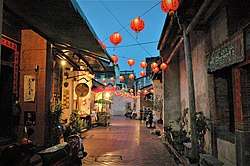Lukang, Changhua
Lukang, formerly known as Lugang and by other names, is an urban township in northwestern Changhua County, Taiwan. The township is on the west coast of Taiwan, facing the Taiwan Strait. Lukang was an important sea port in the 18th century and 19th century. It was the most populous city in central Taiwan until the early 20th century. In March 2012, it was named one of the Top 10 Small Tourist Towns by the Tourism Bureau of Taiwan.[3]
Name
The township's name, which means "Deer Port", came from its deerskin trade during the Dutch period. Its old Taiwanese name was Lok-a-kang (Chinese: 鹿仔港; Pe̍h-ōe-jī: Lo̍k-á-káng) and its shortened version is seen in English texts and maps as variants such as Lok-kang,[4] Lokang[5] and Lo-kiang.[6]
In 2011, the Ministry of Interior decided to keep the historical Wade-Giles spelling "Lukang" and abandon the change to the Pinyin spelling "Lugang" consistent with the switch to Tongyong Pinyin in 2002 and later Hanyu Pinyin 2009.[7]
History
During the Qing Dynasty, the depth of Lukang's harbor and its proximity to Fujian province on mainland China made Lukang an important trading port. During Lukang's heyday from 1785 to 1845, Lukang's population reached 20,000.[8] Lukang was Taiwan's second largest city after Tainan and was larger than Bangka (now a district of Taipei), then the island's third-largest city.
The subsequent silting of the harbor and the city's refusal to allow railroads to pass through the city led to losses in trade in commerce, which, in turn led to Lukang's decline relative to other cities, which were experiencing considerable urbanization and population growth. This same decline, however, averted the modernization processes that demolished historical buildings in Tainan and Taipei, leaving Lukang preserved as it was in the past.
During the period of Japanese rule, the city was Taiwan's fifth most populous city, with a population of 19,805 according to the December 1904 census.[9] The Hoklo people in the area were predominantly of Xiamen and Quanzhou origin,[10] thereby speaking the Quanzhou dialect of Hokkien. Nanguan music is highly popular in Lukang and originates from Quanzhou.

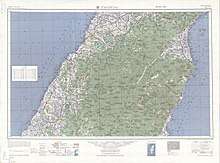
In 1920, Lukang was governed as Rokkō Town (鹿港街) under Shōka District of Taichū Prefecture.
Overview
There are many old temples in Lukang, such as Longshan Temple and Matzu Temple. The city boasts over 200 temples dedicated to a wide variety of folk deities.[11] The town is also the origin of the terms "ē-káng" (下港) and "téng-káng" (頂港) used respectively to refer to southern Taiwan and northern Taiwan; the literal meanings of the terms are "below the harbor" and "above the harbor".
The Yu Jen Jai (玉珍齋) cakes are famous local specialties, as well as Lukang's Ox Tongue Cakes (牛舌餅) and oyster pancakes. It will host the 2012 Taiwan Lantern Festival, beating out six other contenders.[12]
Lukang encompasses 39.46 square kilometers (15.24 sq mi) with a population of 86,779, including 44,115 males and 42,664 females as of January 2017.[13]
Administrative divisions
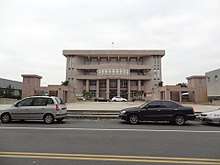
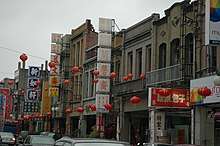
The township comprises 29 villages, which are Dayou, Zhongxing, Luojin, Shunxing, Pulun, Xingong, Yushun, Tungshi, Guocuo, Yongan, Jingfu, Taixing, Zhangxing, Xinghua, Longshan, Caiyuan, Jiewei, Zhaoan, Haipu, Yangcuo, Caozhong, Tounan, Shanlun, Dingpan, Toulun, Gouqi, Liaocuo, Tungqi and Dingcuo.
Infrastructure
Tourist attractions
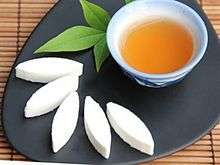
.jpg)
- BRAND'S Health Museum
- Chang Bin Show-Chwan Health Mall
- Eight Wonders
- Lukang Ai Gate
- Lukang Artist Village
- Lukang Culture Center
- Lukang Folk Arts Museum
- Lukang Kinmen Hall
- Lukang Longshan Temple
- Lukang Rimao Hang
- Lugang Mazu Temple
- Lukang Wen Wu Temple
- No Heaven Street
- Taiwan Glass Gallery & Glass Temple
Notable natives
- Chao Shou-po, politician, educator, civic activist and lawyer
- Koo Hsien-jung, former businessperson
- Koo Chen-fu, businessman, diplomat
- Koo Kwang-ming, politician
- Li Ang, writer
- Shi Shuqing, writer
References
Citations
- "鎮長介紹". 11 September 2013. Retrieved 6 January 2019.
- "彰化縣各鄉鎮市 107年12月人口數統計表" (PDF). Retrieved 6 January 2019.
- Wong, Maggie Hiufu (30 March 2012). "Taiwan names its 10 top small tourist towns". CNN Go. Archived from the original on 2 April 2012. Retrieved 31 March 2012.
- Campbell (1896), map.
- Davidson (1903).
- Davidson (1903), map.
- Liu, M. (2011). 鹿港譯名恢復Lukang.United Daily News, retrieved at 28 June 2011.
- DeGlopper (1995), pp. 78–79.
- Takekoshi, Yosaburō (1907). "Chapter XIII: Population and future development of the island resources". Japanese rule in Formosa. London, New York, Bombay and Calcutta: Longmans, Green, and co. p. 200. OCLC 753129. OL 6986981M.CS1 maint: ref=harv (link)
- Davidson (1903), p. 591.
- "Historic town of Lukang boasts over 200 temples". China Post. CNA. 1 March 2010. Retrieved 2 March 2010.
- "Lugang unveiled as host of 2012 Taiwan Lantern Festival". Taiwan Today. 22 February 2011. Archived from the original on 4 March 2016. Retrieved 22 February 2011.
- 統計資料 | 一月 | 表四 [Statistics|January|Table 4]. accounting.chcg.gov.tw (in Chinese). Changhua County Government. 10 February 2017. Retrieved 11 February 2017.
Bibliography
- Campbell, William (1896). "The island of Formosa: Its past and future". Scottish Geographical Magazine. 12 (8): 385–399. doi:10.1080/00369229608732903.CS1 maint: ref=harv (link)
- Davidson, James W. (1903). The Island of Formosa, Past and Present : history, people, resources, and commercial prospects : tea, camphor, sugar, gold, coal, sulphur, economical plants, and other productions. London and New York: Macmillan & co. OL 6931635M.CS1 maint: ref=harv (link)
- DeGlopper, Donald R. (1995). Lukang: Commerce and Community in a Chinese City. Albany: State University of New York Press, Albany. ISBN 9780791426906.
External links
| Wikimedia Commons has media related to Lukang Township, Changhua. |
- Lukang Township Office (in English)
